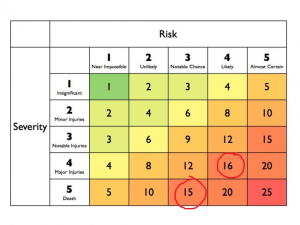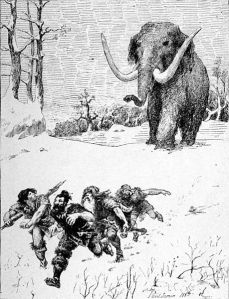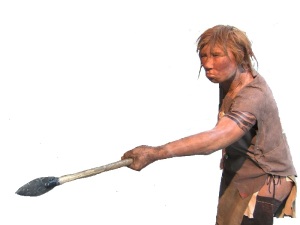Neanderthals didn’t have sexual division of labour?
This has been proposed as a possible explanation as to why the neanderthals died out, i.e. that the women hunted alongside the men regardless of whether they were pregnant or had small children to look after.Well, if it was true, it certainly would explain how they died out. The trouble then would be to explain how they survived 300,000+ years prior to dying out.
As hunting techniques go, neanderthal hunting techiques were extremely dangerous. One study by Erik Trinkhaus (which probably is my favourite peer reviewed journal article ever) demonstrated that they had the same injury patterns as rodeo riders, i.e. the injuries were caused by close contact with large animals, which means they most likely hunted by sticking spears into large animals at close range.
Here is a modern day risk assessment on this kind of hunting:
See? Major injuries likely (16 pts), notable chance of death (15 points) – unacceptable risk by the standards of the modern world.
We are talking about a species of human with a 1400cc average brain capacity. I just simply do not believe that any large brained humans wouldn’t get that it’s better for pregnant women and women looking after small kids to not join in with sticking spears in large animals, and stick to safer activities instead like gathering plant foods.
Not only is there the possibility of severe injury and death to pregnant women and small children, there’s also the fact that hunting by stealth and looking after toddlers are mutually incompatible endeavours. Your toddler won’t keep quiet in the supermarket? Try keeping your toddler quiet while you just go and sneak up on this large wild animal and stick a spear into it…
Some theorise that neanderthal women hunted small animals, but this is still sexual division of labour, i.e. men hunting very big animals like mammoths and reindeer and women hunting small animals like rabbits, which are not likely to break your bones. Sexual division of labour means men doing one thing and women doing something else, and generally involves women sticking to safer ways to acquire food which are more compatible with bearing and raising children, while the men do the dangerous stuff.
Sexual division of labour isn’t an either-or situation. There can be different degrees of it. For the sake of simplicity, I’m going to divide it into three possible scenarios:
1. Men and women hunted equally, i.e. no sexual division of labour at all.
2. Women hunted sometimes, but not as much as men. Pregnant and lactating women did not join in the hunt, while non-mothers and women whose surviving children were old enough either to join in with the hunt or stay with the pregnant and lactating women went hunting.
3. Women did not hunt at all, it was purely a man thing. (Or they only hunted small, safe animals.)
Among modern human hunter-gatherers, you can find all three, but 2 and 3 are the most typical, with a bias towards 3 as far as I’m aware.
Given that a) Neanderthal hunting methods were very dangerous, and b) they lived in smaller groups than Homo sapiens, I think that 3 is the most likely scenario for the Neanderthals. The death of a woman has a much more significant impact on the future population size than the death of a man. One man can impregnate two or more women, but one woman can’t bear twice as many children to make up for the death of another woman in the tribe. The smaller the population, the bigger the impact that the death of one woman has. Thus men are more expendable than women, so populations where only men do dangerous things like ramming middle palaeolithic spears into large animals at close quarters will have a better chance of survival.
I think that situation 2 above arises from biology, and is the pattern that you would have seen in earlier human societies and in later humans whose hunting methods are not so dangerous, or whose population sizes are big enough that one or two women dying in hunting accidents won’t make too much of a difference. I’m a human and I’ve been pregnant, and I’m also very much a “tomboy”, in that I used to play ice hockey with the men, and also dangerous games like British bulldog on ice without any helmets or other protective equipment, oh yeah and that was with men too. So I’m probably the kind of woman who would have gone hunting with the men, if raised in a hunter gatherer tribe with no taboo against women hunting. However I can assure you that while pregnant I would not have been able to do any of those things, due to morning sickness, tiredness and I guess what you’d call maternal instinct. And the same while breastfeeding. This is why I think that it’s in our biology for women to not go hunting while pregnant or caring for small children, and that the genes that code for this were selected for before humans evolved enough frontal lobe capacity to be able to realise that it’s a good idea for pregnant and lactating women not to hunt (i.e. long before the Neanderthals evolved).
The difference between 2 and 3 I believe would be a matter of culture. Women are physically capable of hunting and while there’s variation between women, i.e. some women are much more “tomboyish” than others, plenty of women enjoy aggressive sports, which are probably the nearest modern equivalent to middle palaeolithic hunting, so in the absence of a cultural taboo against hunting, I’d predict that some women in middle palaeolithic tribes would have wanted to join in with hunting large animals, and would have done so as long as they’re neither pregnant nor in the grip of “new mum”/lactation hormonal changes. It would have had to have been a cultural taboo against women hunting (or against women hunting large animals) that would result in 3.
With this selection pressure, I think it’s likely that Neanderthal women rarely, if ever, hunted with the men. That does not mean they were passive and delicate, because they would have had to defend themselves and their children while the men were out hunting, and the fossil record shows they were heavily built and very strong and they probably did have to learn how to use a spear for defence. I think it’s reasonable to suggest that occasionally women may have gone hunting with the men in adverse circumstances, e.g. if due to deaths or injuries within the tribe there were not enough able bodied men to hunt effectively (the men would have hunted in bands and used strategies to corner or trap animals before killing them; that requires a sufficient numbers of hunters), but I think there would have been sexual division of labour.
The most conclusive evidence though would be in the fossil record, i.e. whether Neanderthal women have the same injury patterns as modern day rodeo riders or if it’s just Neanderthal men that do.
middle: The Mammoth, by Paul Jamin, public domain





Share your opinion on this post